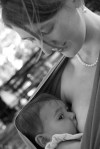
There are so many reasons to breastfeed, and among them is: 1) to protect baby from disease while traveling; 2) convenience when traveling; 3) much cheaper than formula. I’ve had a successful and rewarding breastfeeding relationship with my daughter that has created a very close bond between us. We’re still going strong at 21 months. Some women have difficulties breastfeeding, but if you are able to and willing to work through some of the challenges, it is so rewarding, and the best (and easiest) source of food on the go for baby!
When Veda was six weeks old, I had to travel to Paraguay for two weeks for work. My husband came along to take care of baby during the day, and I sometimes had very long days where I was going on long road trips to the field, leaving at 3am and returning at 11pm. I had a lot of pumping to do. It was challenging. I was stuck in a jeep with another woman and two men most of the time, sometimes for 5 to 8 hour stretches, so I had to pump in the car with colleagues I had just met on bumpy unpaved roads. I sacrificed my pride and privacy to give my baby the best source of nutrition possible, and it was worth it. I have continued pumping on and off as needed when I am going to be away from Veda for long periods of time for work (but not overnight).
I did a lot of research on breast pumps, as I was committed to continuing breastfeeding, despite this work interruption. There are tons of pumps on the market, many of them very expensive (especially the electric ones), but that were completely impractical for travel. I settled on purchasing one travel-friendly electric pump (for efficiency), and one manual pump (for back-up in case batteries died or I had a power issue with recharging). 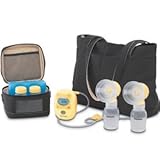
1) Electric Pump: Medela Freestyle This thing is an amazing, powerful little pump perfect for travel in developing countries (or anywhere else). It’s a bit on the expensive side (but moderate as compared to other electric pumps). t’s extremely small and compact, and I was surprised by the suction power the little thing has. It has a rechargeable battery that I only need to charge every week (for every day use), and the power lasts until the battery dies. It is really great and convenient for travel, especially if you won’t always have the option of a power outlet. The only problem is that it is electric, so it is a bit noisy. Thus, when I’ve had to pump in a car with others, for example, I’ve used my hand pump.
 2) Manual Pump: Lansinoh Before I went electric, I exclusively used this manual pump. I’ll admit, I was a little intimidated by hooking up power to by nipples, and it took me a couple of months for me to make that leap. For $30, it’s worth every penny, and just as effective as my electric pump. But, I can only do one breast at a time, so it takes longer than the double electric pump, and it can get a bit tedious sitting (sometimes on a toilet seat in a public restroom-eeeek the places I’ve pumped!). But, it’s a great back-up to an electric pump, gets the job done, and is significantly quieter (e.g. noiseless) for needing to pump in close spaces- like cars
2) Manual Pump: Lansinoh Before I went electric, I exclusively used this manual pump. I’ll admit, I was a little intimidated by hooking up power to by nipples, and it took me a couple of months for me to make that leap. For $30, it’s worth every penny, and just as effective as my electric pump. But, I can only do one breast at a time, so it takes longer than the double electric pump, and it can get a bit tedious sitting (sometimes on a toilet seat in a public restroom-eeeek the places I’ve pumped!). But, it’s a great back-up to an electric pump, gets the job done, and is significantly quieter (e.g. noiseless) for needing to pump in close spaces- like cars ![]() .
.
I have also found that a few accessories are essential: 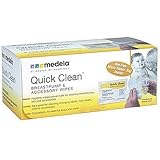
1) Breast pump cleansing wipes When I was out on the road for long periods of time and needing to pump multiple times, I found it useful to carry with me some disposable cleansing wipes (like hand wipes/ baby wipes). This allowed me to clean the pump attachments of milk after use and sterilize it so that I could use the pump again later in the day without worrying about washing, when I often had no option for washing and didn’t want to wash my pump with water that could be contaminated.
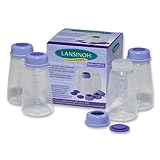 2) 8-10 breast milk storage bottles I find it useful to have reusable breast milk storage bottles with me, especially places we are at for more than a couple of weeks. It requires a bit more diligence than disposable bags, but it’s more cost-effective and better for the environment. We just make sure that each day we sterilize used bottles in boiling water. These bottles work with both the Lansinoh manual pump and the Medela electric Freestyle Pump.
2) 8-10 breast milk storage bottles I find it useful to have reusable breast milk storage bottles with me, especially places we are at for more than a couple of weeks. It requires a bit more diligence than disposable bags, but it’s more cost-effective and better for the environment. We just make sure that each day we sterilize used bottles in boiling water. These bottles work with both the Lansinoh manual pump and the Medela electric Freestyle Pump.
3) Disposable breast milk storage bags These are essential because: 1) they are small and compact for traveling/ packing; and 2) they are hygienic since you toss the bag after using the milk and don’t have to worry about sanitizing bottles. If you are traveling for work, I have had to bring a small stock of 24 -36 ounces (4-6 bottles/ bags) of already pumped milk so that I could leave baby with milk the day I arrived somewhere. You are allowed to fly with milk for baby in your carry-on bag over the allowed liquid limit (with an ice-pack to keep it cool).
4) Breastfeeding- friendly bottles for baby All babies are different and have different preferences. My baby transitioned to using cups by 11 months, but when she did drink from a bottle she was an extremely picky bottle-feeder (she prefers the breast, of course). So, when I had to be gone for sometimes longer than 12 hour stretches and she was refusing to drink out of regular bottles, I began searching for alternatives. When I found a few that worked, I realized why- they feel and look so much more like the breast than other standard bottles on the market! The following are great bottles if you need to be away from baby and he or she has a strong breast preference:
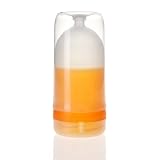 1) Adiri BPA Free Natural Nurser: This comes in different flow selections: slow for 0-3 months, medium for 4-6 months, and fast for 6 + months. I especially love these bottles not only for how soft and breast-like they are, but also because of the design they are easy to clean and less parts than most other bottles (it’s one long latex bottle with a screw bottom). When my daughter still drank from bottles, this is the only bottle she would use in addition to the Yoomi below, and this Adiri is a lot less of a hassle and less expensive than the Yoomi.
1) Adiri BPA Free Natural Nurser: This comes in different flow selections: slow for 0-3 months, medium for 4-6 months, and fast for 6 + months. I especially love these bottles not only for how soft and breast-like they are, but also because of the design they are easy to clean and less parts than most other bottles (it’s one long latex bottle with a screw bottom). When my daughter still drank from bottles, this is the only bottle she would use in addition to the Yoomi below, and this Adiri is a lot less of a hassle and less expensive than the Yoomi.
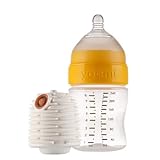 2) Yoomi: This thing is an insane and expensive ($43 for the bottle and warmer that needs replacement after 100 uses). $50 for one freaking bottle?? It’s expensive because it’s a self-warming bottle that warms the milk as it passes over a “charger” to the perfect temperature of breast milk. It’s a bit of a hassle because it requires boiling the charger for about 30 minutes in hot water to charge it, and then it requires cooling it for over an hour and a half, so you need to be prepared with the heating and cooling process well before baby needs to be fed. It sounds a bit ridiculous, but it was worth it for us it was the only bottle that Veda would drink out of for a while.
2) Yoomi: This thing is an insane and expensive ($43 for the bottle and warmer that needs replacement after 100 uses). $50 for one freaking bottle?? It’s expensive because it’s a self-warming bottle that warms the milk as it passes over a “charger” to the perfect temperature of breast milk. It’s a bit of a hassle because it requires boiling the charger for about 30 minutes in hot water to charge it, and then it requires cooling it for over an hour and a half, so you need to be prepared with the heating and cooling process well before baby needs to be fed. It sounds a bit ridiculous, but it was worth it for us it was the only bottle that Veda would drink out of for a while.
Two other bottles that I purchased and I think are also great bottles, and much more reasonably priced than the Yoomi, but that my daughter personally did not prefer (she has expensive taste), are the Mimijumi Very Hungry Baby Bottle and the Comotomo Natural Feel Baby Bottle.
5) Nursing pads If you breastfeed, you will leak. I have several times leaked through shirts, and still do these days despite less nursing at 14 months. Nursing pads are a must if breastfeeding to prevent leaks, as well as to keep the area sanitary. In the beginning when I leaked frequently (not as much anymore), I often changed my nursing pads 2-3 times a day. It’s a good idea to change them frequently to avoid infection like mastitis. I tried three different kids of nursing pads: disposable, washable cotton, and reusable silicone. 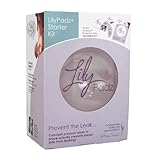
My favorite are the reusable Lilypadz because they don’t get soggy and bunch up and make it look like I’m stuffing my bra (they just stick right on over the nipple), do a fairly good job of preventing leaks in the first place (it presses the nipple in), and I could go bra-less or strapless easily with them to wear strapless dresses in summer time. The only problem is that they need to be washed after you take them off to breastfeed or pump (and it helps maintain them longer if you use theLilypadz wash), so if you don’t have access to clean potable water while traveling, they aren’t the best for traveling sans water.
I like Bamboobies Ultra-Thin Regular Nursing Pads because they are comfortable, fit well into the bra with a bit of shape to them, and can be washed and re-used. The only problem is they have a tendency to bunch up and are on the thicker side. The disposable nursing pads are great especially for long travel/ airplane rides as they can be easily disposed of and replaced with fresh clean pads.
6) Nipple Butter Sounds sexy, right? Once the milk starts bursting through tiny holes in your nipples and a little baby is sucking away, it’s useful to have a travel-friendly pot of nipple butter to help relieve sore and/or cracked nipples. I like organic formulas such as Natural Nipple Butter or Motherlove Herbal Nipple Cream that make me feel better about what my baby is putting her mouth on. It’s small enough to easily throw in a purse, diaper bag, or carry-on.
7) Breastfeeding-friendly tea It’s still a good idea to continue abstaining from caffeine when breastfeeding, which can be passed through mother’s milk to baby. Drinking decaffeinated tea is also a good way to stay hydrated, which is a must while breastfeeding and to keep the milk flowing. I noticed, more when Veda was very little, that if I did indulge in a cup of coffee she was fussier and had more difficulty sleeping. Decaffeinated tea is a good comforting hot drink alternative, and there are several teas with herbs that help with milk production, as well.
8) Nursing bras Especially early on, it is useful to get a variety of nursing bras. I found comfortable sleep nursing bras to be particularly useful for night-time wear (otherwise I woke up on a big wet stop from leaking breasts), as well as comfortable day-time nursing bras. I like nursing bras that either easily pull to the side or have an easy hook on the strap that can be unhooked and pulled down. It’s best to go to a specialty maternity store and get fitted, keeping in mind your breast size will change throughout pregnancy and during nursing. I also found it useful to have, both during pregnancy and for nursing, to have a comfortable strapless bra.
9) Bottle drying rack This is not essential, but I found it extremely useful to keep bottles and pump parts sterile after cleaning them. It is useful to make sure they adequately dry and are kept away and separate from other possible contaminates. This drying rack comes apart and is compact and light, which makes for easy packing. Happy nursing and pumping!
Don’t forget that breastfeeding and baby wearing go hand-in-hand. It will make it really easy for you to discretely nurse your baby on a plane, through airport security, and while traveling with a good comfy baby wrap, like the Moby wrap.
Related Pages:
Six Reasons to Choose Breastfeeding on the Go
Guide to Getting Baby’s Liquids Through Security
15 Essentials to Include in Baby’s Carry-On
13 Baby Essentials that May be Hard to Find When You Arrive
Related articles
- Three tips for making pumping less painful and awkward (mamaot.com)
- Breast Pumps for Nursing Moms (webmd.com)
- Feeding and the Working Mom (enfamil.com)
- Breastfeeding Resources (aurinh.wordpress.com)
- Just the Essentials! Part 3: Babywearing & Breastfeeding. (whuffling.wordpress.com)
4 thoughts on “Essential Breastfeeding Gear for Traveling Mommas”